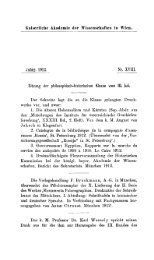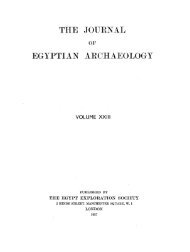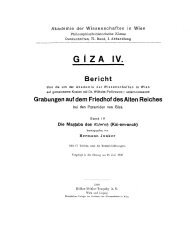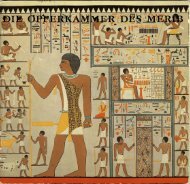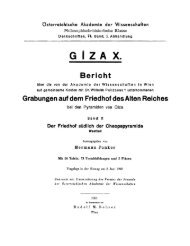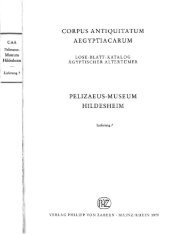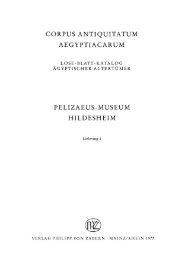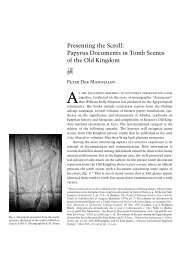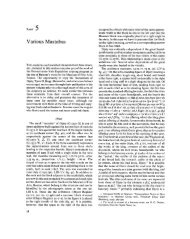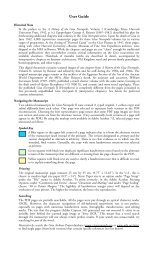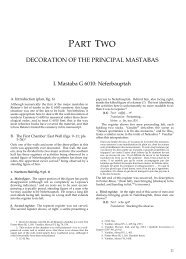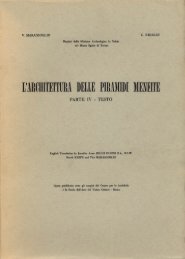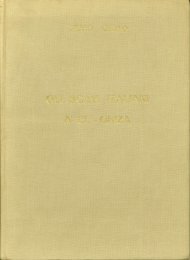58 SOUROUZIAN - Giza Archives Project
58 SOUROUZIAN - Giza Archives Project
58 SOUROUZIAN - Giza Archives Project
You also want an ePaper? Increase the reach of your titles
YUMPU automatically turns print PDFs into web optimized ePapers that Google loves.
A Headless Sphinx of Sesostris II from<br />
Heliopolis in the Egyptian Museum,<br />
Cairo, JE 37796<br />
Hourig Sourouzian<br />
he many contributions of Kelly Simpson to the history of<br />
Egyptian Art, and particularly his scholarship on the history of<br />
the Middle Kingdom, are of great importance. It is an honor to<br />
participate in these studies presented to him with an object from his<br />
period of predilection, which I hope will bring a pleasant addendum to<br />
his rich catalogue of Middle Kingdom documents.<br />
The sphinx was found rebuilt in the Mosque of Mottahar, in the<br />
Gamaliya district of Old Cairo, and entered the Egyptian Museum in<br />
1905. 1 It bears the no. JE 37796; 2 T<br />
the conserved height is 47 cm, the<br />
length 162 cm (figs. 1–3).<br />
The recumbent sphinx, which was carved in a greenish graywacke<br />
and was very smoothly polished, has suffered extremely from damage by<br />
both time and reuse. The head, paws and base are now lost; the left side<br />
and the lower part of the right flank have been cut to serve in a modern<br />
construction. A severe blow has mutilated the middle of the back. In<br />
spite of the bad state of preservation, this object bears enough indices to<br />
reveal excellent workmanship, the name of its owner and the provenance<br />
of the sculpture and, finally, to show a feature of iconography<br />
which appears to be an important dating criterion.<br />
On the mutilated chest, a fragment of the left lappet of a nemes is<br />
still preserved, and on the back, a remnant of a projection indicates the<br />
tip of the nemes tail. The stylized tufts of the mane hair are incised in<br />
parallel lines down the shoulders. A broad collar is carved around the<br />
1 It was on exhibit in the garden of the Museum flanking its east side. Later, this part of<br />
the garden was temporarely closed to the public. Recently, on the initiative of the director,<br />
Dr. Mohamed Saleh, it was decided to reopen this sector again to visitors. The reorganization<br />
of the exhibit is carried out by May Trad. I thank Dr. Saleh for the kind permission to<br />
study and publish this monument, and Adel Mahmoud for his constant kind and friendly<br />
assistance with all my researches at the Museum. And my special thanks go to Peter Der<br />
Manuelian for editing my English.<br />
2 See also nos. SR 212 and TR 16.2.21.6.
Studies in Honor of William Kelly Simpson<br />
Figs. 1–3. Sphinx of Sesostris II, Cairo JE 37796 Fig. 2.<br />
744<br />
Fig. 3.
Fig. 4. Sphinx of Sesostris II, detail of<br />
the chest.<br />
Fig. 5. Sphinx of Sesostris II, detail of<br />
the collar.<br />
Hourig Sourouzian, A Headless Sphinx of Sesostris II from Heliopolis in the Egyptian Museum, Cairo, JE 37796<br />
neck, and on the chest an incised inscription in three columns gives the<br />
Horus and throne names of Sesostris II, who is “beloved of the Souls of<br />
Heliopolis, lords of the Great Sanctuary.”<br />
The rounded rump at the back of the leonine body is better preserved,<br />
with the root of the tail, the thigh of the right hind paw and knee,<br />
encircled by the upper part of the tail which ends with a long grooved<br />
and striated tuft. Thus this statue of Heliopolitan origin represented<br />
King Sesostris II as a recumbent sphinx, with leonine body and human<br />
head, wearing a nemes headdress; his chest was adorned by a broad collar.<br />
This type of sphinx, most common in Egyptian sculpture, is well<br />
attested since the Old Kingdom, and best illustrated by the Great Sphinx<br />
of <strong>Giza</strong>.<br />
In the Middle Kingdom, royal sphinxes are produced in great number<br />
and on a colossal scale, but very few have kept their original inscriptions<br />
or were found in their original position. Most of these sphinxes have<br />
been scattered all over the Delta, displaced, reused, and reinscribed,<br />
sometimes several times, from the Hyksos dynasties up to the Third<br />
Intermediate Period. Numerous magnificent specimens, now bearing<br />
names of later kings, belong to predecessors and successors of<br />
Sesostris II, and can be identified either by scanty remains of their own<br />
name or on solid stylistic criteria, especially if the heads are preserved.<br />
But if the sphinxes are headless or uninscribed, when they appear with<br />
recarved heads and altered inscriptions, it is more difficult to trace them<br />
back to their actual date. For this reason, sphinxes that clearly bear the<br />
titulary of Sesostris II are otherwise unknown and this explains the<br />
small number of monuments inscribed with the name of this king. 3<br />
Ironically, this single identified sphinx of Sesostris II, having exceptionally<br />
escaped alteration in later dynasties, was destined to be cut and reused<br />
as building material in relatively recent past. The loss of the head<br />
and a great part of the body, deplorable for the study of the style, is compensated<br />
by a rare feature in the otherwise common iconography, which<br />
brings a new dating criterion to a well known type. Indeed, the iconography<br />
is uncomplicated: the preserved pleated fragment of the lappet of<br />
the nemes is rendered in the traditional way by regular, horizontal,<br />
raised ridges tightly alternating with parallel grooves (fig. 4). This feature<br />
is known on all sculptured nemes examples from the Fourth<br />
Dynasty up to the Middle Kingdom (fig. 5), independently from the<br />
3 See H.G. Evers, Staat aus dem Stein II (Munich, 1929), pp. 105–109; Simpson, in LÄ V,<br />
cols. 899–903; Vandier, Manuel III, pp. 181–84; Altenmüller, in LÄ III, 565; Jaroß-Deckert,<br />
Statuen, CAA Wien, Lieferung I (Mainz, 1987), pp. 55–59; B. Fay, The Louvre Sphinx and<br />
Royal Sculpture from the reign of Amenemhat II (Mainz am Rhein, 1996), chapter VII.<br />
745
Studies in Honor of William Kelly Simpson<br />
pattern of the upper part and wings of the headdress, which can vary<br />
from reign to reign and even within a reign. 4 From the Thirteenth<br />
Dynasty on, the lappets are provided with an inner border which reappears<br />
sporadically in the Eighteenth dynasty, especially during the reign<br />
of Amenhotep III and later in the Nineteenth Dynasty, when the pattern<br />
of the lappets is frequently altered to larger pleats. 5 The parallel incised<br />
lines rendering the tufts of the mane, most common during the Twelfth<br />
Dynasty on this type of sphinx with royal headdress, run down the<br />
shoulders on both sides of the chest, from the lower border of the nemes<br />
lappets, down to the start of the destroyed forepaws; the innermost line<br />
coincides with the inner edge of the lappets.<br />
The tail of the lion, which is round in section, curls upward on the<br />
right side to encircle the knee, and ends with a broader tuft hanging<br />
down the rump and rendered in raised relief (fig. 7). It is divided horizontally<br />
by shallow grooves indicating the waves, which in turn are incised<br />
with incurved striations, representing the curled strains. A horizontal<br />
band limits the striations at the tip of the tuft which is flat and perpendicular<br />
to the sphinx’s body. The nearest parallels to this type of tail are<br />
attested on sphinxes of the Twelfth Dynasty. On the red granite sphinx<br />
of Sesostris’ predecessor, Amenemhat II, from Tanis (Louvre A 23), 6 the<br />
tail is equipped with a similar tuft, but it is shorter and ends higher on<br />
the rump (fig. 8). A tail similar in shape, length and striations may be<br />
observed on the sphinx of Nebesheh in Boston (MFA 88.747), which has<br />
recently been attributed to Sesostris II. 7 In the reign of his successor,<br />
Sesostris III, the gneiss sphinx in the Metropolitan Museum of Art<br />
(MMA 17.9.2), presumably deriving from Karnak, 8 has a tail tuft with<br />
grooves and observes the same length as that of Sesostris II. On the<br />
quartzite sphinx of this king (of unknown provenance) now in the<br />
British Museum (E 1843), 9 the length of the tuft is similar but the<br />
grooves fewer and more widely spaced. Of the two sphinxes of Amen-<br />
4 Evers, op. cit., pp. 11–16.<br />
5 Evers, op. cit, p. 13, no. 70–73.<br />
6 Evers, Staat aus dem Stein I, pls. 48–50, ibid., II, pp. 42–46; this sphinx is now safely dated<br />
to the reign of Amenemhat II by B. Fay, op. cit.<br />
7 Fay, op. cit., Sphinx Appendix No. 28, pl. 86 a–d.<br />
8 Evers, op. cit., pls. 78–79; C. Aldred, in MMJ 3 (1970), pp. 43–44, fig. 25; L. Habachi, in<br />
MMJ 19/20 (1986), pp. 11–16, fig. 6; N. Cherpion, in RdE 42 (1991), fig. 4; F. Polz, Studien<br />
zur Porträtplastik Sesostris’ III und Amenemhets III., unpublished Master’s thesis, University<br />
of Heidelberg 1990, cat. no. 38; see finally, with fuller bibliography: W. Seipel, Gott<br />
Mensch Pharao (Vienna, 1992), cat. no. 44; Fay, op. cit., Sphinx Appendix No. 30, pl. 87a, b.<br />
9 Werke ägyptischer Kunst, Auktion 46, Münzen und Medaillen AG (Basel, 1972), pl. 23,<br />
no. 34, pl. 9; H. Goedicke, JSSEA 7, 4 (1977), p. 10; N. Cherpion, op. cit., fig. 8; Fay, op. cit.<br />
Sphinx Appendix No. 32, pl. 86e–h; F. Polz, op. cit., cat. no. 40.<br />
746<br />
Fig. 6. Sphinx of Amenemhat II,<br />
Louvre A 23.<br />
Fig. 7. Sphinx of Sesostris II, detail of the<br />
tail.
Fig. 8. Sphinx of Amenemhat II, detail<br />
of the rump.<br />
Hourig Sourouzian, A Headless Sphinx of Sesostris II from Heliopolis in the Egyptian Museum, Cairo, JE 37796<br />
emhat III found in Syria, the fragmentary one sculptured in green schist,<br />
now on exhibit in the Damascus National Museum (former Aleppo no.<br />
473), 10 shows a tail which ends at the same length but with fewer<br />
grooves and incised striations. By contrast, on the diorite headless small<br />
sphinx of the Aleppo Museum (no. 6450), 11 the tail ends with an undetailed<br />
and flatter tuft. From the end of the Twelfth Dynasty, two<br />
sphinxes found in Abukir and exhibited in the Graeco-Roman Museum<br />
of Alexandria, repeat the type of the Amenemhat III sphinx tail: one inscribed<br />
for Amenemhat IV with a much damaged tail, and its companion<br />
piece, usurped by Ramesses II, with a better preserved tail. 12 It is<br />
worth noting that on the mane of sphinxes with leonine hair tuft, 13 the<br />
tail is always much shorter and ends in a bulbous appendice, inherited<br />
from the tail form of the rarely preserved examples from the Old<br />
Kingdom. 14<br />
10 PM VII, p. 393; C.F.A. Schaeffer, Ugaritica 4 (1962), p. 223, fig. 25; Polz, op. cit., cat.<br />
no 108.<br />
11 PM VII, p. 395; Scandone-Mathiae, RdE 40 (1989), pp. 125–29, pl. 4; Polz, op. cit., cat.<br />
no. 107.<br />
12 Evers, op. cit., pls. 135–36; Fay, op. cit., Sphinx Appendix Nos. 55 (pl. 94c) and 56.<br />
13 Attributed to Amenemhat III: Cairo CG 391, 393, 394, 530, 1243, SR 175 and 202.<br />
Amenemhat IV, British Museum <strong>58</strong>892: U. Schweitzer, Löwe und Sphinx im Alten<br />
Ägypten, ÄF 15 (Glückstadt and Hamburg, 1948), pl. X, 8; Fay, op. cit., Sphinx Appendix<br />
No. 54, pl. 94a, b. Two Middle Kingdom sphinxes reshaped and reinscribed by Ramesses II<br />
are now in Ismailia (forthcoming article, in preperation).<br />
747
Studies in Honor of William Kelly Simpson<br />
The broad collar on the sphinx of Sesostris II is partly destroyed<br />
(fig. 5). The remaining lower part is not interrupted by any trace of a<br />
raised structure, which may indicate that the sphinx was beardless or, if<br />
there was a beard, the base of its plinth would have been placed higher<br />
on the chest. The collar was composed of several rows of tubular beads<br />
of which the two lower rows only are preserved. They are set vertically<br />
between horizontal bands, the lowermost of which is doubled and bordered<br />
by a row of drop-shaped pendants. The rows of vertical beads as<br />
well as their joining bands are entirely incised on the chest, while the<br />
drop-shaped pendants are carved in shallow relief. The broad collar is<br />
attested on statues since the Old Kingdom, and include examples painted<br />
around the neck. 15 Carved examples reappear on royal statuary in the<br />
Twelfth Dynasty, the first known being on the sphinx of Amenemhat II<br />
in the Louvre, where the collar is incised on a raised surface, and the<br />
rows of incised vertical beads are all set between single bands rendered<br />
in raised relief (see fig. 6). Thus the collar of Sesostris II on the sphinx<br />
under discussion is the second known carved example within the surely<br />
dated royal statues, and it introduces a double lowermost band between<br />
the last row of tubular beads and the drop-shaped pendants.<br />
While the single banded collar of Amenemhat II will remain as the<br />
classical type in royal sculpture, be it incised or carved in relief, the<br />
double-banded frame seems to be attested only sporadically and for a<br />
limited time. In two-dimensional representations, it appears occasionally<br />
on royal 16 and private monuments. 17 In sculpture in the round,<br />
it is observed on a few royal statues bearing royal names of the Twelfth<br />
and the Thirteenth Dynasties, and when they are uninscribed, they can<br />
be attributed by other criteria to the end of the Twelfth Dynasty.<br />
On the female limestone statue discovered by Petrie in Abydos and<br />
generally known as the “princess of Abydos,” 18 the broad collar is<br />
14 Djedefrê, Cairo JE 35137: PM III, p. 3; Hornemann, Types of Ancient Egyptian Statuary,<br />
1523. Merenrê: National Museum of Scotland 1984.405: J.Bourriau, JEA 72 (1986), p. 180,<br />
fig. 1; Fay, op. cit., Sphinx Appendix No. 13, pl. 84a–b, d. Pepi II: Moscow, Fay, op. cit.,<br />
Sphinx Appendix No. 14.<br />
15 Carved on a statue of Snofru: R. Stadelmann, in Kunst des Alten Reiches, SDAIK 28<br />
(Mainz am Rhein, 1995), pl. 62; painted on statues of Mycerinus: see Reisner, Mycerinus,<br />
pls. 44–45.<br />
16 Bas-reliefs of Sahure (L. Borchardt, Sa£¢ure II (Leipzig, 1913), pls. 17, 18, 22, 33); and<br />
Sesostris III (F. Bisson de la Roque et J.J. Clère, Rapport sur les fouilles de Médamoud<br />
(1928), FIFAO VI (Cairo, 1929), pl. IV,2.<br />
17 Example in an Old Kingdom mastaba, Hassan, <strong>Giza</strong> IX, pl. XVI; Middle Kingdom: reliefs<br />
of the tomb of Siesi, Cairo TR 24.5.28.1, 24.5.28.2 and 24.5.28.3; see De Morgan,<br />
Dahchour, pl. XIV.<br />
18 Cairo, JE 36359; PM V, p. 43; Petrie, Abydos I, p. 33, pl. LXX,12; Maspero, Guide to the<br />
Cairo Museum (Cairo, 1903), p. 98, no. 228.<br />
748
Hourig Sourouzian, A Headless Sphinx of Sesostris II from Heliopolis in the Egyptian Museum, Cairo, JE 37796<br />
Fig. 9. “Princess of Abydos,” Cairo<br />
JE 36359.<br />
Fig. 10. Fragment of a female statue,<br />
Cairo.<br />
worked on a raised surface and composed of seven rows of vertical beads<br />
set between bands in shallow relief, the upper- and the lowermost of<br />
which are doubled (fig. 9). This statue bears all the characteristics of the<br />
Twelfth Dynasty, and was recognized as such by Evers, 19 but its dating<br />
has often been disputed, without convincing argumentation, and ranges<br />
from the Twelfth to the Thirtieth dynasties. 20<br />
The right upper fragment of a limestone bust, 57 cm high, whose<br />
provenance is not recorded, is stored in the Egyptian Museum, Cairo.<br />
Around the neck can be seen the remains of a broad collar with three<br />
preserved rows of vertical beads set between bands in shallow relief, the<br />
uppermost of which is doubled (fig. 10). The material, the style of the<br />
sculpture, the wide tripartite wig, and the treatment of the ear with<br />
schematized anatomy, as well as the wide back slab, all are comparable<br />
to the iconography and style of “the princess of Abydos,” and these two<br />
monuments cannot but be contemporary, if not of identical provenance<br />
as well. 21<br />
19 Staat aus de Stein I, pls. 51–52; ib. II, pp. 102–105.<br />
20 See most recently H. De Meulenare, “Meskhenet à Abydos,” in Fs. Derchain, Religion<br />
und Philosophie im Alten Ägypten, Orientalia Lovaniensia Analecta 39 (Leuven 1991), pp.<br />
243–49, pl. 1. For a safer attribution of this sculpure in the Middle Kingdom, see Biri Fay,<br />
forthcoming article in MDAIK 52 (1996).<br />
749
Studies in Honor of William Kelly Simpson<br />
Three similar examples of carved broad collars with doubled upper<br />
and lower bands are found on divine statues, 22 discovered by Petrie in<br />
the temple of Amenemhat III in Hawara. 23 Two of these are adorned by<br />
a collar worked on a raised surface, with the bands and drop-shaped<br />
beads in relief; on the third statue the whole collar is incised on the<br />
chest, and only the pendant beads are worked on a sunk surface.<br />
Two statues in red granite, one found on Elephantine and stored in<br />
the Museum of Aswan, 24 the second in the temple of Tod, 25 both represent<br />
a seated king wearing the heb-sed cloak and holding the crook and<br />
flail. The statues are uninscribed but bear iconographic criteria datable<br />
to the Twelfth Dynasty, such as the royal insignia with longer handles<br />
than those of other periods. On both statues, a broad collar with double<br />
upper and lower bands ends on each shoulder by semi-circular clasps<br />
which are too damaged to show if they were once incised with the<br />
details of a falcon’s head.<br />
A fragmentary statue in Tanis, reinscribed by Ramesses II, was discovered<br />
in the approach to the temple of Khonsu. On the chest is a very<br />
finely carved broad collar with double upper and lower bands, and a single<br />
band framing the drop-shaped pendants. For certain anatomic and<br />
iconographic criteria, this statue under study can also be attributed to<br />
the Twelfth Dynasty. 26<br />
Finally, the last of the well-dated royal effigies is the limestone double<br />
statue of Neferhotep I from Karnak, now in the Egyptian Museum,<br />
Cairo (figs. 11–12). 27 It represents the king twice, standing in a niche, the<br />
chest adorned with an incised broad collar framed by double bands and<br />
bordered by pendants in shallow relief. We can conclude that, independently<br />
from the technique, which appears to alternate between the<br />
21 Petrie, Abydos I, p. 31, claims to have found several fragments of a statue group in crystalline<br />
limestone. This could be one of the fragments he mentions to have belonged to a<br />
“joining statue.”<br />
22 Cairo, RT 30.9.14.9, RT 1.10.14.1 and RT 1.10.14.2. I owe to the courtesy of Dr.<br />
Mohammed Saleh the opportunity to see, study and photograph these sculptures in storeroom<br />
R 17, and Mrs. Salwa Abd el-Rahman, who kindly helped me during my work.<br />
23 Petrie, The Labyrynth, Gerzeh and Mazghuneh (London, 1912), pp. XXIV and XXV (bottom<br />
right). Biri Fay, whom I thank for this reference, is preparing a study on these divine<br />
statues.<br />
24 Inv. 1091; h. 62 cm. See Sourouzian, in Hommages à Jean Leclant I (Cairo, 1994), p. 511,<br />
no. 15, fig. 1d.<br />
25 Torso: inv. 2518, h. 67 cm; lower part: h. 90 cm. See Hommages Leclant I, p. 512, no. 16,<br />
fig. 2a.<br />
26 The statue is unpublished. I thank Philippe Brissaud, Director of the French Mission of<br />
Tanis, for kindly allowing me to study the fragments and entrusting me with their publication<br />
in the forthcoming Cahiers de Tanis.<br />
27 Legrain, Statues et Statuettes de rois et de particuliers I, CG 42022, pp. 13–14, pl. XIII.<br />
750<br />
Fig. 11. Neferhotep I, CG 42022.<br />
Fig. 12. Neferhotep I, detail of collar.
Hourig Sourouzian, A Headless Sphinx of Sesostris II from Heliopolis in the Egyptian Museum, Cairo, JE 37796<br />
carved and the incised, the feature of the double bands framing a broad<br />
collar, can be considered as characteristic of the Twelfth and the Thirteenth<br />
Dynasties. 28 The sphinx of Sesostris II would then be the first<br />
example, among the well dated monuments, to bear this feature.<br />
The inscription on the chest of the sphinx is composed of three incised<br />
hieroglyphic columns set in a rectangular frame, on the top of<br />
which is the sign of the sky. It reads: “Horus, leader of the Two Lands,<br />
given life, stability and dominion, the good god, lord of the Two Lands,<br />
forever, beloved of the Souls of Heliopolis, lords of the Great Sanctuary”<br />
(fig. 4).<br />
The b£w ⁄wnw, best translated as Souls of Heliopolis, seem to “indicate<br />
the divinized dead kings” of that city, 29 and are repeatedly attested<br />
throughout Egyptian history. On certain statues and sphinxes from<br />
Heliopolis, the name of the king is followed by the epithet “beloved of<br />
the b£w ⁄wnw,” 30 often completed by the title Lords of the Ìwt-£. 31<br />
This Ìwt-£, generally translated as great mansion or temple, 32 seems to<br />
refer to a sanctuary in Heliopolis 33 mentioned in the documents of the<br />
New Kingdom in relation to official ceremonies, such as the coronation<br />
of the king by Atum and the celebration of the royal jubilee. 34<br />
Thus, the sphinx of Sesostris II derives most certainly from Heliopolis,<br />
and can be associated with the great sanctuary of that city, since<br />
the king apparently dedicated the statue to the Souls of Heliopolis on an<br />
official occasion. The vicinity of Heliopolis to the present-day capital<br />
explains the frequent reuse of its monuments in buildings of Old<br />
Cairo. 35 Before the reuse of the sphinx, it is very probable that it was still<br />
in situ and visible in Heliopolis. If its head was taken to Italy in the<br />
Roman Period or, presuming it had survived until the search for<br />
Egyptian Antiquities by dealers during the nineteenth century, it should<br />
28 In the New Kingdom the uppermost band is doubled on a completely different type of<br />
collar, with floral design, for example on the “White Queen” in Cairo, CG 600.<br />
29 LÄ I, 380. See Kees, Götterglaube, p. 156–57; L.V. ¸abkar, A Study of the Ba Concept in<br />
Ancient Egyptian Texts, SAOC 34 (Chicago, 1968), pp. 22–33.<br />
30 Sphinx of Pepi I, Cairo CG 541; statue of Psametik I in Alexandria, near the Pompei Pillar:<br />
A. Rowe, Bulletin de la Société Royale d’Archéologie d’Alexandrie no. 35, NS Vol. XI,<br />
(1942), pp. 154–55, pl. XXXIII, D.2; and two sphinxes of Apries in Alexandria, Kom el-<br />
Shugafa, no. 90 and 91: Daressy, ASAE 5 (1904), p. 127.<br />
31 Obelisk of Sesostris I in Heliopolis (PM IV, p. 60; Habachi, The Obelisks, p. 49); base of<br />
a monument of Sesostris I in Berlin, 7720 (PM IV, p. 63, Roeder, Ägyptische Inschriften I,<br />
p. 140).<br />
32 LÄ II, col. 1111; see Helck, ZÄS 82 (1957), pp. 112–16.<br />
33 See E. El-Bana, “Deux études héliopolitaines,” BIFAO 85 (1985), pp. 149–63.<br />
34 See the naos of Ramses II found in Tell el-Maskhuta: K. Myåliwiec, BIFAO 78 (1978), p.<br />
189, fig. 7.<br />
35 See PM IV, pp. 69–73.<br />
751
Studies in Honor of William Kelly Simpson<br />
be located somewhere in a collection abroad. If the neck is preserved, a<br />
double band at the start of the broad collar would be a valuable clue for<br />
matching the dispersed elements.<br />
Until such a match takes place, this fragmentary sculpture adds a<br />
new document to the short list of statues of Sesostris II, which are all either<br />
headless or fragmentary. 36 As for the complete statues attributed to<br />
him, 37 their features were so much altered by the Ramesside kings that<br />
they cannot be used to describe a portrait of Sesostris II. To complete the<br />
idea of the head of the Cairo sphinx, the only reference of comparison<br />
would be the granite bust with unaltered features found in Memphis and<br />
now in the Ny-Carlsberg Glyptothek in Copenhagen (ÆIN 659; see fig.<br />
13). 38 On the belt of the king, the scanty remains of inscriptions can be<br />
restored to the throne name of Sesostris II: Ój-Ópr-R. 39 The King’s<br />
headdress is the nemes with low top and very wide wings. The lappets,<br />
free of interior border, repeat the tightly alternating ridges and furrows<br />
of the classical type, but the coiffe of the nemes is decorated by one large<br />
and two narrower raised bands alternating with sunk spaces. The frontal<br />
band which joins the ears is narrow and rendered in raised relief. Two<br />
lappets emerge in front of each ear; the hood of the uræus is based at the<br />
lower border of the frontal band, its tail in relief forming two loops before<br />
ending on the top of the head. The portrait depicts a young ruler<br />
with a round and large face, high cheek-bones and a wide chin. The long<br />
and arched eyebrows are worked in raised relief; the elongated eyes, bordered<br />
on their upper eyelid by a thin rim in raised relief are set horizontally,<br />
their inner canthi prolonged slightly obliquely towards the nose.<br />
Under the lower eyelids, a depression enhances the modeling of the<br />
cheeks. The nose is short, with a thin root and shows, in spite of the<br />
damage, a wide base with duly modeled wings flanked by two oblique<br />
furrows joining the corners of the mouth. The latter is horizontal, much<br />
wider than the base of the nose, the lower lip being thicker, with a<br />
curved contour disappearing, before the end of the upper lip, at the corners<br />
of the mouth into slight hollows. The chin is limited horizontally<br />
36 See footnote 3.<br />
37 Cairo CG 430 and 432; Berlin 7264; Vienna ÄS 5776. See Evers, op. cit., pp. 105–109.<br />
38 PM III, p. 863.<br />
39 The remaining signs are a sun-disk, very small and placed high up at the start of the cartouche,<br />
followed by the upper part of a sign which seems to be the head of the beetle (∞pr),<br />
the arm of a k£, or the plume of M£t. Thus the name can well correspond to Ój-∞pr-R<br />
(Sesostris II), and, less likely, due to incompatibility of style, to Nbw-k£w-R<br />
(Amenemhat II), Ój-k£w-R (Sesostris III), or Nj-M£t-R (Amenemhat III). I am most<br />
obliged to Dr. Mogens Jørgenson for this indication and thank him very kindly for his<br />
warm hospitality in the Glyptothek, for the splendid photograph and the kind permission<br />
to illustrate the bust.<br />
752
Fig. 13. Sesostris II, Ny Carlsberg<br />
Glyptothek, ÆIN 659.<br />
Hourig Sourouzian, A Headless Sphinx of Sesostris II from Heliopolis in the Egyptian Museum, Cairo, JE 37796<br />
by the royal beard which ends high above the lower border of the nemes<br />
lappets. The ears occupy a space on the sides of the face between the line<br />
of the eyes and that of the mouth; they are set obliquely on the frontal<br />
plane and worked in detail in such raised relief that the ears are fully visible<br />
from the front and the side views simultaneously; the helix, forming<br />
753
Studies in Honor of William Kelly Simpson<br />
a raised frame, curves and disappears behind the projecting tragus. The<br />
short neck is advanced, its root being much lower than the line of the<br />
shoulders. The stocky torso is smoothly modeled in nuances. These features<br />
are also repeated on the two statues of Queen Nofret, consort of<br />
Sesostris II 40 and on contemporary private statues. 41<br />
754<br />
b<br />
40<br />
Cairo CG 381 and 382; Evers, Staat I, pls. 72–75.<br />
41<br />
See Evers, Staat I, pls. 61–63; Habachi, The Sanctuary of Heqaib, AV 33 (Mainz am<br />
Rhein, 1985), no 15, pls. 42–45.



